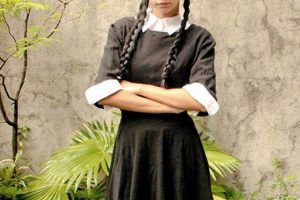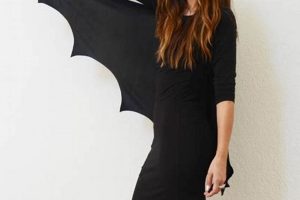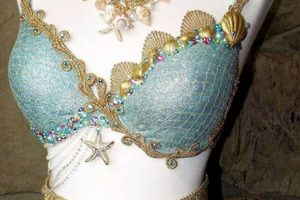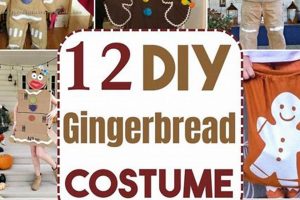The creation of a homemade mermaid princess outfit involves the construction of a costume inspired by the character from Disney’s “The Little Mermaid.” This process typically includes assembling or crafting components such as a tail, top, and accessories using readily available materials or repurposed items. For instance, a shimmering green fabric might be fashioned into a tail, while a seashell-inspired top could be created from a repurposed bra or purchased fabric.
Constructing the ensemble oneself offers a cost-effective alternative to purchasing a pre-made costume. Furthermore, it allows for a high degree of personalization and customization, ensuring a unique appearance. The practice of making such outfits has grown in popularity alongside the broader trend of handcrafted and upcycled fashion, fueled by a desire for originality and resourcefulness.
The following sections will provide detailed instructions on how to craft each element of this iconic character’s attire, focusing on achieving a recognizable and appealing aesthetic through accessible techniques and budget-friendly materials. Guidance will be provided on tail construction, top design, accessory selection, and makeup application to complete the transformation.
Crafting a Mermaid Princess Ensemble
The following suggestions aim to optimize the creation process of a homemade mermaid princess costume, ensuring a visually appealing and durable result. Careful attention to detail during each stage of construction contributes to the overall success of the project.
Tip 1: Fabric Selection: Opt for stretchable fabrics with a subtle shimmer for the tail. Spandex, stretch velvet, or sequined fabrics provide a realistic and comfortable fit while allowing for ease of movement.
Tip 2: Tail Construction: Prioritize creating a sturdy fluke. Consider using craft foam or lightweight plastic sheeting to provide structure. Secure the fluke material to the tail fabric using strong adhesives and reinforced stitching.
Tip 3: Seam Reinforcement: Reinforce all seams, especially those on the tail, with multiple rows of stitching or serging. This prevents ripping or tearing during wear, particularly in areas subject to stress.
Tip 4: Scale Detailing: Apply scales using fabric paint, adhesive-backed gems, or individual sequins. Employ a stenciling technique for uniform scale placement or create a randomized pattern for a more natural appearance. Ensure that the adhesive is appropriate for the chosen fabric type.
Tip 5: Top Design: Select a bra or crop top that provides adequate support and coverage. Embellish with seashells, pearls, or iridescent beads using a strong adhesive or by sewing them on securely. Consider adding netting or tulle for visual texture and depth.
Tip 6: Accessory Selection: Incorporate accessories such as a starfish hair clip, shell necklace, or wrist cuffs to enhance the overall aesthetic. These elements should complement the color palette of the costume and avoid overwhelming the design.
Tip 7: Makeup Application: Use waterproof makeup to create a shimmering, aquatic-inspired look. Emphasize the eyes with shades of blue, green, and purple. Apply a highlighter to the cheekbones and brow bone for a luminous effect.
Adhering to these recommendations will contribute to a more professional and long-lasting result, ensuring that the handcrafted mermaid princess costume is both visually striking and durable.
The subsequent sections will explore advanced techniques for achieving specific design elements and troubleshooting common challenges encountered during the costume creation process.
1. Fabric selection
Fabric selection is a foundational consideration in the creation of a self-made mermaid princess costume. The choice of material directly influences the costume’s aesthetic appeal, comfort, durability, and overall success in replicating the desired character representation. Careful consideration of fabric properties is therefore paramount.
- Aesthetic Replication
The fabric’s color, texture, and shimmer contribute directly to replicating the visual aspects of the character. For example, iridescent or scale-printed fabrics evoke the aquatic nature of the costume, while a material’s drape determines the flow and movement of the tail. Inaccurate fabric choices can detract from the intended appearance.
- Comfort and Wearability
Fabrics must allow for comfortable movement and extended wear. Stiff or scratchy materials can cause discomfort, particularly in areas of direct skin contact. Stretch fabrics, such as spandex blends, offer flexibility and a conforming fit. Consideration of fabric breathability is important, especially for prolonged use.
- Durability and Longevity
The fabric’s inherent strength and resistance to wear and tear affect the costume’s longevity. Delicate fabrics may be prone to rips or snags, especially in areas subject to friction or stress. Reinforced stitching and proper care are essential to mitigating potential damage. Durable fabrics are more cost-effective in the long term.
- Construction Feasibility
The fabric’s properties dictate the ease with which it can be cut, sewn, and embellished. Fraying fabrics require additional finishing techniques, while slippery fabrics may be challenging to manipulate during construction. The chosen fabric must be compatible with the intended construction methods and embellishment techniques.
Ultimately, appropriate fabric selection is not merely an aesthetic consideration but a functional one. Selecting fabrics that balance visual accuracy, comfort, durability, and ease of construction is crucial to creating a successful and satisfying mermaid princess costume. Compromising on fabric quality can negatively impact the final outcome, regardless of the skill involved in other aspects of the costume’s creation.
2. Tail Construction
Tail construction represents a critical component in the successful realization of a self-made mermaid princess costume. Its form, function, and aesthetic quality are central to the overall visual impact and believability of the ensemble. A well-executed tail can significantly enhance the costume’s resemblance to the character, while a poorly constructed tail detracts from the intended effect.
- Material Selection and Durability
The materials employed in tail construction must balance aesthetic appeal with durability and flexibility. Fabrics like spandex or stretch velvet offer visual similarity to scales while providing necessary freedom of movement. Reinforcement of seams and the fluke (tail fin) is crucial to withstand stress and prevent tearing. Inadequate material selection leads to premature wear and reduces the costume’s lifespan. A common exampl
e is the use of non-stretch fabrics, resulting in restricted movement and potential seam failure. - Fluke Design and Structure
The fluke, or tail fin, serves as a focal point of the costume. Its shape, size, and construction contribute significantly to the overall aesthetic. A well-structured fluke requires internal support, often achieved with craft foam or plastic sheeting, to maintain its shape and prevent drooping. Insufficient support results in a limp, unrealistic appearance. Consider commercially available monofins incorporated within the fluke structure, offering a realistic swimming motion.
- Scale Detailing and Application
Replication of scales enhances the realism of the tail. Scales can be achieved through various methods, including fabric paint, individual sequins, or textured fabrics. Consistent application and strategic placement are crucial. Uneven spacing or poorly adhered scales diminish the visual impact. Employing stencils or pre-printed scale fabric can streamline the application process.
- Closure Mechanisms and Fit
A secure and comfortable closure is essential for proper fit and ease of wear. Options include zippers, elastic waistbands, or adjustable straps. The closure mechanism must be discreet to maintain the costume’s aesthetic integrity. Ill-fitting tails impede movement and can pose safety hazards. Accurate measurements and pattern adjustments are necessary to ensure a secure and comfortable fit.
These interconnected facets of tail construction demonstrate its pivotal role in the successful creation of a homemade mermaid princess costume. A holistic approach, considering material properties, structural integrity, and aesthetic detail, is necessary to achieve a visually compelling and durable final product. Neglecting any of these elements compromises the overall effectiveness of the costume.
3. Top Embellishment
Top embellishment, within the context of a self-made mermaid princess costume, constitutes a pivotal design element directly influencing the costume’s overall aesthetic and character accuracy. The selection and application of embellishments to the top piece contribute significantly to the visual representation of the character. Without appropriate embellishments, the costume may lack the necessary visual cues to establish a clear association with the intended character, diminishing its effectiveness as a recognizable representation. The embellishment phase allows for personalization, yet adherence to core design attributes inherent to the character’s top is essential.
Examples of top embellishments include the application of seashells, imitation pearls, or iridescent beads. The strategic placement of these elements aims to replicate the visual style associated with the character. Furthermore, the use of fabric paints to simulate textures or patterns commonly associated with mermaid-themed attire enhances the visual effect. For instance, applying a subtle shimmer using fabric paint imitates the reflective quality of scales. Failure to adequately secure embellishments poses a risk of detachment during wear, potentially compromising the costume’s integrity. Secure attachment is, therefore, integral to the successful execution of this phase.
In conclusion, appropriate top embellishment is crucial to the creation of a visually compelling mermaid princess costume. Thoughtful consideration of design elements, secure application techniques, and adherence to characteristic details are essential for achieving a successful outcome. Overlooking this element may result in a costume that fails to effectively capture the essence of the intended character, thus diminishing its overall impact. Adherence to established embellishment techniques, therefore, serves as a critical aspect in costume creation.
4. Accessory Choice
Accessory choice functions as an integral element in the realization of a self-constructed mermaid princess costume, substantially influencing the overall aesthetic and the authenticity of the representation. The selection of appropriate accessories transcends mere ornamentation; it serves to reinforce the character’s identity and complete the visual narrative. In the context of a do-it-yourself project, accessory choice provides opportunities for creative expression and resourcefulness, leveraging available materials and skills to achieve a cohesive design. For example, a strategically chosen starfish hair clip, crafted from repurposed materials or purchased economically, can effectively enhance the aquatic theme. Conversely, the inclusion of inappropriate or mismatched accessories can detract from the intended impression, weakening the overall impact of the costume. The deliberate selection of accessories, therefore, constitutes a critical step in successfully embodying the character.
Considerations in accessory choice encompass several dimensions, including thematic coherence, color coordination, and scale appropriateness. Accessories should align with the aquatic environment and the character’s established visual attributes. Examples include shell necklaces, wrist cuffs resembling coral, and repurposed fishing nets adapted as decorative accents. Furthermore, color coordination between accessories and the primary costume components is crucial for visual harmony. Disproportionately large or small accessories can disrupt the costume’s balance and detract from its believability. The level of craftsmanship invested in accessories should mirror that of the primary costume elements, ensuring a consistent level of detail and quality across the entire ensemble. This integrated approach strengthens the overall visual presentation.
In summary, accessory choice occupies a significant role in the construction of a homemade mermaid princess costume. The deliberate selection of thematically appropriate, well-coordinated, and proportionally scaled accessories effectively amplifies the costume’s visual impact and enhances its connection to the intended character. While the creation process presents opportunities for creative ingenuity and resourcefulness, the ultimate goal remains the cohesive and compelling representation of the iconic character. Overlooking this critical element can diminish the overall effectiveness of the project, highlighting the importance of careful planning and execution.
5. Makeup Application
Makeup application forms a critical and often overlooked element within the scope of a self-constructed mermaid princess costume. While the costume’s structural components, such as the tail and top, establish the foundational aesthetic, makeup application serves to enhance the character’s features and solidify the overall illusion. The absence of appropriate makeup undermines the costume’s potential, diminishing its impact. Therefore, the connection between makeup application and the successful execution of such costumes represents a significant factor in achieving a believable and aesthetically pleasing result. For instance, a meticulously crafted tail paired with everyday street makeup can create a discordant effect, detracting from the overall impression.
The principles of makeup application for this purpose involve employing aq
uatic-themed color palettes, such as blues, greens, and purples, to mimic the iridescent qualities associated with marine life. Techniques such as highlighting and contouring can sculpt the face, creating a more ethereal or otherworldly appearance. Furthermore, the use of waterproof products is essential to prevent smudging or running, particularly in environments where moisture or perspiration is present. A real-world example lies in the application of shimmering eyeshadow to emulate the scales of a fish, coupled with the strategic use of eyeliner to accentuate the eyes, resulting in a heightened sense of character embodiment. The application extends beyond mere color; it incorporates shading and highlighting to create depth and dimension, resulting in a transformation beyond simple costuming.
In conclusion, makeup application serves as a key element in bridging the gap between costume and character. A thoughtfully applied makeup design that complements the costume’s structural components elevates the overall presentation, resulting in a more convincing and visually impactful mermaid princess persona. Challenges may include achieving a balance between theatrical makeup and a natural appearance, as well as adapting techniques to suit individual skin tones and facial features. However, the importance of this element should not be underestimated in the context of creating a complete and convincing self-made mermaid princess costume.
Frequently Asked Questions
This section addresses common inquiries and misconceptions regarding the creation of a do-it-yourself mermaid princess costume, providing clarity on essential aspects of the construction process.
Question 1: What is the most cost-effective material for constructing the tail?
Stretch fabrics such as spandex blends or knit polyesters represent cost-effective choices. These materials offer a balance between visual appeal, flexibility, and affordability, making them suitable for budget-conscious projects. Consider sourcing remnants or discounted fabrics to further reduce material costs.
Question 2: How can the fluke of the tail be reinforced without adding excessive weight?
Lightweight plastic sheeting or craft foam can provide structural support to the fluke without significantly increasing weight. These materials are readily available and can be easily cut and shaped to the desired form. Adhering multiple layers of craft foam can further enhance rigidity.
Question 3: What adhesive is recommended for securing embellishments to the top?
Industrial-strength adhesive suitable for fabric and embellishments is necessary to prevent detachment. Follow the manufacturer’s instructions carefully and test the adhesive on a small, inconspicuous area before applying it to the entire top. Hot glue guns can also provide a secure bond, but exercise caution to avoid burning the fabric or skin.
Question 4: How can scales be applied to the tail in a uniform and efficient manner?
Employing stencils can streamline the process of scale application, ensuring consistent spacing and alignment. Pre-cut stencils in various scale shapes and sizes are commercially available, or custom stencils can be created using cardboard or plastic sheets. Apply fabric paint or adhesive-backed gems using the stencil as a guide.
Question 5: What type of makeup is best suited for underwater photography or performances?
Waterproof makeup is essential for maintaining a flawless appearance during underwater activities or performances. Utilize waterproof foundation, eyeliner, mascara, and eyeshadow to prevent smudging or running. Setting sprays designed for waterproof makeup can further enhance its longevity.
Question 6: How can a comfortable and secure fit be ensured for the tail?
Accurate measurements are crucial for achieving a comfortable and secure fit. Take measurements of the waist, hips, and length from the waist to the ankles. Adjust the pattern accordingly to accommodate individual body dimensions. Incorporating an elastic waistband or adjustable straps can further enhance fit and adjustability.
Key takeaways include the importance of selecting durable and cost-effective materials, employing appropriate adhesives and application techniques, and prioritizing comfort and fit during the construction process. Careful planning and attention to detail contribute to a successful and satisfying outcome.
The following section explores advanced techniques for enhancing the aesthetic appeal and functionality of a self-made mermaid princess costume.
DIY Ariel Costume
The preceding analysis has dissected the multifaceted process of constructing a self-made mermaid princess costume, addressing crucial aspects from material selection to makeup application. Fabric choice, tail construction, top embellishment, accessory selection, and makeup application are not isolated elements but interdependent components that collectively contribute to the final representation. A comprehensive understanding of these interconnected dimensions is essential for achieving a visually compelling and structurally sound result.
The creation of a convincing DIY Ariel costume, therefore, transcends mere replication; it necessitates a strategic synthesis of creative vision, technical skill, and meticulous execution. Those embarking on this endeavor are encouraged to meticulously plan each stage, paying careful attention to the materials used and the methods employed. The ultimate objective remains the faithful embodiment of a beloved character through a concerted effort that respects both the source material and the craft itself.







